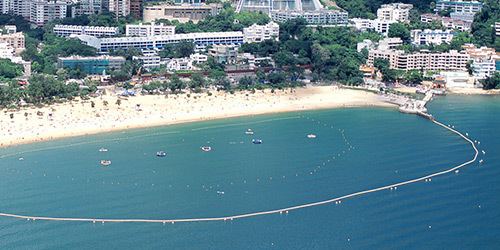Chinese 淺水灣 Hanyu Pinyin Yale Romanization Chin Seui Waan | Literal meaning Shallow Water Bay Romanization Cien Sui Van Jyutping Cin Seoi Waan | |
 | ||
Similar Victoria Peak, Lamma Island, Hei Ling Chau, Po Toi Islands, Lantau Island | ||
Hong kong repulse bay and kuan yin temple trip to china part 73 full hd travel video
Repulse Bay is a bay in the southern part of Hong Kong Island, located in the Southern District, Hong Kong.
Contents
- Hong kong repulse bay and kuan yin temple trip to china part 73 full hd travel video
- Map of Repulse Bay Hong Kong
- Geography
- History
- Present
- Features
- Road
- Railway
- References
Map of Repulse Bay, Hong Kong
Geography
Repulse Bay is located in the south of Hong Kong Island, to the east of Deep Water Bay and to the west of Middle Bay and South Bay. Middle Island, Hong Kong is located off Hong Kong Island, between Repulse Bay and Deep Water Bay.
History
The origins of the bay's English name have become extremely obscure. There are, however, many stories — none resting on any solid evidence that has so far been established. A typical example is that in 1841, the bay was used as a base by pirates and caused serious concern to foreign merchant ships trading with China. The pirates were subsequently repulsed by the Royal Navy, hence the name. There is no evidence of any such origin in the extensive British naval log books of the period. Another story holds that the bay was named after HMS Repulse which was stationed at the bay at one point. No HMS Repulse ever visited Hong Kong, let alone Repulse Bay and the 1868 Repulse served only on the west coast of the Americas (1872-77) and thereafter in British waters. It is known that the name appeared on the earliest British official map of Hong Kong by Lt TB Collinson RE in 1845. However, British Admiralty charts never used the name until the 20th century, instead sticking to the quite erroneous name given by Commander Edward Belcher RN in his 1841 survey, Chonghom Bay. The source of the name remains unknown.
In the 1910s, Repulse Bay was developed into a beach, and the Repulse Bay Hotel was built in 1920. To attract swimmers, a bus route from Central to Repulse Bay was created, and now stands as one of Hong Kong's oldest bus routes. During the Battle of Hong Kong in World War II, Repulse Bay was an important strategic location.
The beach was extended artificially, and thus the sand closer to the shore is coarser in texture than the sand further away.
Until the early 1960s, residential buildings were quite restricted. Three blocks of six storey apartments were developed by Dr. P. P. Chiu and his brother P. W. Chiu, part way up the mountain overlooking Repulse Bay. These were luxury apartments with servants' quarters, with only two apartments per floor in Blocks A and B. Apartments in Block C are smaller. For a long time, these were the only apartments allowed on the mountain.
Occupying the whole of the west side cliff above the beach was a large castle with a swimming pool, greenhouse and tennis court called Eucliffe, one of three castles owned by the millionaire Eu Tong Sween. The Eucliffe structure and historical site was demolished to make way for a row of low apartments.
Present
The Repulse Bay area is one of the most expensive housing areas in Hong Kong. In 2012, some townhouses reached HK$50,000 (US$6,500) per square foot.
The former Repulse Bay Hotel was demolished in 2 stages during the 1970s and 1980s. Later a boutique shopping mall was constructed on part of the old hotel site to mimic some of the lost colonial architecture.
Emperor International Holdings Limited bought Lido Mall at Repulse Bay and renamed it The Pulse, but due to its expansion to five storeys and 143,000 sq ft, it has been in negotiations with the government over the land premium. On 15 May 2012, Emperor announced an agreement with the government with the land premium at HK$798 million. Emperor will put The Pulse up for lease after receiving the occupation permit. The 143,000-square-foot, five-story shopping mall will be rented out at HK$50 to HK$60 per square foot.
Features
Road
Repulse Bay is served by Repulse Bay Road, which connects Wong Nai Chung Gap Road and Tai Tam Road. It is very convenient for people to travel to Repulse Bay as there many bus routes from Central, such as no. 6, 6A, 6X, 260; or the no. 40 minibus. Transportation either takes one express through the Aberdeen Tunnel, or along the slightly longer scenic route.
Beach-goers may also opt to drive there. The beach provides some parking space, and the nearby Repulse Bay Hotel also has parking facilities.
Railway
There are no MTR stations in Repulse Bay, nor has any MTR project been proposed or commenced there.
